Khajuraho. I was there at last. As an acute sense of elation filled me, I momentarily forgot the horrendous journey that I had to take from Jabalpur to get here. The heavy rains only added to pitiful road conditions resulting in a tiresome six-hour drive. My situation worsened on deciding to stay in the first guest house I could find. The room rents were slightly on the higher side considering it’s an off season. With no energy to hunt around for accommodation, I settled on what I have. Rain continued to lash out its fury on the sacred village as I tucked myself in for a quick nap.
The pleasant aroma of pakodas from a restaurant nearby lured me out of bed. After a generous helping of pakodas, I ventured out only to come back almost immediately as the skies opened up for the second time. I spent my time socializing with the only other guest in that hotel. The two gentlemen from Germany were very friendly and I was soon able to strike a friendly conversation with them. Little did I know that these men would become my travel buddies till Gwalior.
Taking the gigantic umbrella given to us by the hotel staff, we made our way to temples for the sound and light show. I dozed off several times during the show only to be woken up by my German friends. The historic facts presented were very bland and the light sequences were unsynchronized. Strolling around the neighborhood after a sumptuous dinner ended the rather uneventful day on a high note.
The next day the Sun made its presence known on the ‘Sun Temple’ amongst the famed Western Group of Temples. In this post I shall try to find answers to questions that had eluded me in the past…
Who built the temples at Khajuraho?
The Chandella Dynasty (AD 900 – 1150) is credited for these magnificent temples. The Chandella genealogy traces its roots back to mythic beginnings. Legend has it that Chandra, the moon god, fell in love with a beautiful young Brahmin maiden, Hemavati, and out of wedlock a child was born marking the beginning of the Chandella Dynasty. Hemavati, worried of having a child out of wedlock asked the Moon god to forgive her sins. Chandra prophesied that their son, after becoming the king should perform Bhandya Yajna , a sacrificial ritual that included among its rites the depiction of erotic figures. This would free his mother from the blemish of extramarital love. However there is no mention of the love story in the inscriptions found at the site. Archaeologists have traced the ancestry of Chandellas’ to tribal Gonds and Bhars as they worshipped a tribal deity called Maniya Devi. This could possibly be an attempt by the Chandellas to hide their tribal past with glorified stories to improve their status from chieftains to kings.
Was there any religion at all in Khajuraho?
The name Khajuraho is synonymous with erotic sculptures. It’s generally believed that ‘free love’ was born there. Some also believe that the sex manual Kamasutra was written after studying Khajuraho. Nothing could be further from the truth. Erotic figures consist of not even one-tenth of the total number of sculptures that adorn the walls of the temples. The temples were the centers of both religious and artistic expression in medieval India. There is abundant evidence to support that religions like Hindus, Jain Digambara, and traces of Buddhist faith were present during the glorious days of Khajuraho. Irrespective of family deity being of tribal origin, the Chandellas built temples in sophisticated Nagara style and affiliated to Brahmanical religion (Vedic). There are five temples dedicated to the Jain faith which are located at the Eastern Group Of Temples. A detailed explanation of erotic sculptures of Khajuraho can be found in here.
Was the Tantric sect of Kapalikas associated with Khajuraho?
Popular belief associates Khajuraho with the extreme sect of the Kapalikas, who were Brahmin –haters who, it is believed, indulged in sexual rites. In the literature of the period, the Kapalikas were believed to have abducted beautiful girls for sacrificing to the Devi, the Goddess. D.N Lorenzen, a leading authority on the history of the Kapalika sect, disassociates this sect from Khajuraho temples. He points out that it represented a stage in Indian history when orthodox Brahmin forces reasserted themselves against extreme Tantric sects such as Kapalikas. By the 10th century AD, the Puranas (Brahmanic Religion) which had earlier opposed the Tantras, now accepted several Tarntric elements such mantras, yantras, and mandalas. Thus the religion at Khajuraho was Tantric-Puranic. Unlike the Kapalika sect, they were not extreme Tantric, but were influenced by Vedic revival and had incorporated Puranic elements.
Strolling around the temple complex, I noticed the similarities between all the temples. Almost all the temples have the northern style Shikhara (Tower), Garbhagriha (Sanctum), Antarala (Vestibule), Mahamandapa (A Large Hall), Mandapa (A Hall), Mukhamandapa (A Porch). The sculptures are made of finely grained stone ranging from pale buff to pink, yellow, and brown.
The main sanctum where the god resides is often very dark, perhaps to give an atmosphere where the devotees are reborn to higher life. I found it rather strange that all the temples follow the same pattern of construction. It’s only later that I learnt that they were constructed based on rules laid down in texts called Vastushastra.
Having visited many ancient temples in the South India, I was quite aware of the architectural differences notably the absence of enclosure walls. It has its own separate platform that demarcates its sacred space from the material world. The arched gateways (Toranas) of the temple are richly decorated providing a cosmic welcome to the eternal world. My thoughts were interrupted by my German friends who reminded me of little time we have to explore all the temples in the area.
Devangana Desai, a renowned expert in Khajuraho sculptures, has broadly classified them into eight categories. Unlike many Hindu temples found around the country, these groups of temples follow a certain pattern in design.
The Cult Icons: The Khajuraho temples were dedicated to Vishnu, Shiva, Surya and The Yoginis. The artists have created some of the most extraordinary images of these divinities which represent gods as divine celestial beings. Perhaps the most interesting sculpture is of Kartikeya, the war god and the son of Lord Shiva, depicted as a teacher of grammar, shows the vast cultural diversity in understanding of the god between the various regions in India.

Cult Icons: Shiva-Parvati - The idol represents unity of Lord Shiva and Goddess Parvati By Combining Half Body Of Each Other
The Attendants & Surrounding Divinities: The images are found all around the temples are generally vital figures, believed to radiate the power of the central divinity of the sanctum.
The Demi Gods: These are dynamic figures generally carved on the top row of the wall, symbolizing the celestial world. As load-bearing, four armed dwarfs, they are seen on pillar brackets of all the temples, some of them with funny expressions on their faces.
Celestial Women: The medieval temples of India, including those at Khajuraho, have a preponderance of female figures in their sculptural scheme. The women indulge in various everyday activities such as applying make-up, tying or untying the waist girdle, rinsing water from wet hair etc. The medieval Vastu texts specifically ordain the carving of female figures on the temple walls. One of the common depictions is of a women undressing to remove a scorpion from her body. This was a poetic device used to express fertility. Female nudity was regarded as a potent fertility charm. It is often pointed out that one of the Sanskrit words for scorpion is Khajura, and this could be related to the ancient name of Khajuraho, i.e. Khajura-vahaka, which means either date-palm bearing or scorpion bearing. Perhaps the scorpion bearing female could be the emblem of the town Khajura-vahaka.
Amorous Couples: The erotic groups, related to the auspicious symbolism of early Indian art, acquire added importance at Khajuraho. The understanding of these erotic figures and their depictions are often so complex that a separate post is dedicated to their understanding.
Secular Scenes: The depiction of royal hunt, the king at the court, marching armies, domestic scenes are all classified as secular scenes.
Animal Figures: The common form of Mythical figures found in Khajuraho temples are the Vyala, which is originally derived from Persian art. This creature, with body of a lion and the face of an elephant, goat, parrot, was known in India from at least the second century BC. Makara, the mythical creature is often found on the arched frames of divinities.

Animal Figures: Makara: This mythical creature combines the jaw of a crocodile, trunk of elephant, ears of lion, horns of ram, and tail of fish. It is the vehicle of goddess Ganga
Geometric & Floral Designs: These are carved on the ceilings, on pillars and elsewhere.
Having visited all the temples at Khajuraho, I was thinking about the other aspect proposed by a well renowned scholar Shobita Punja about the actual depictions of the figures around the temple. According to her understanding the depictions around the temple often point to a mythical divine marriage between Shiva and Parvati. She points out that a story that starts on Maha Shivaratri and ends with the night of wedding of Shiva and Parvati.
Place To Stay:
- Hotel Siddharth – Ph: 274627 Rent: Rs 800
- Osaka Lodge – Ph: 272839 Rent: Rs 400
References:
- Khajuraho The First Thousand Years – Shobita Punja
- Khajuraho with latest discoveries – P.K Mishra
- Khajuraho – Devangana Desai
- Khajuraho – A study of the cultural conditions of Chandella society. – Vidya Prakash



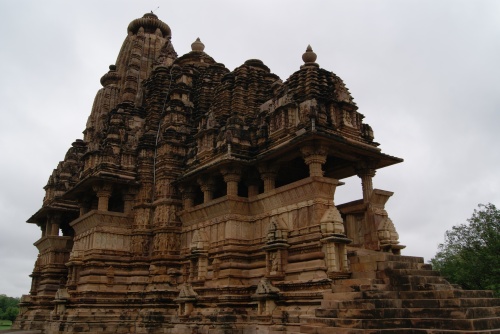
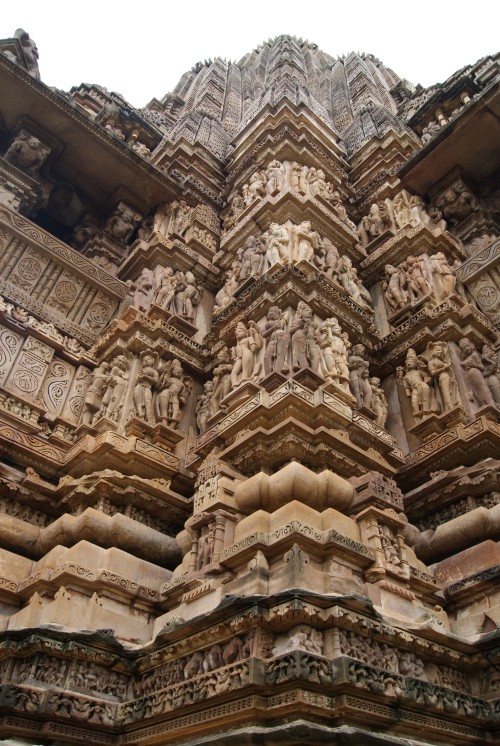






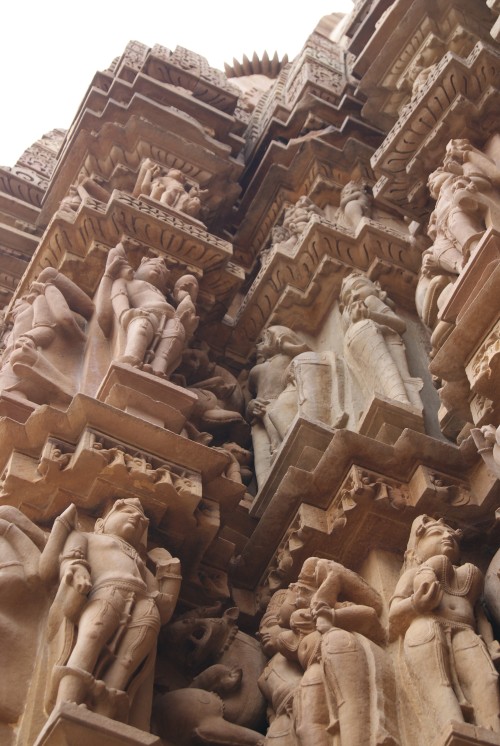




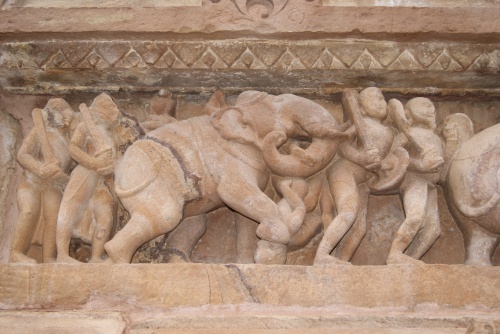
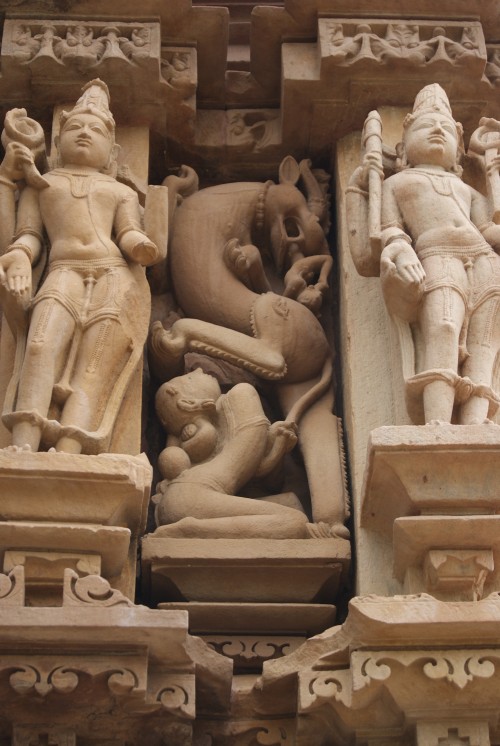


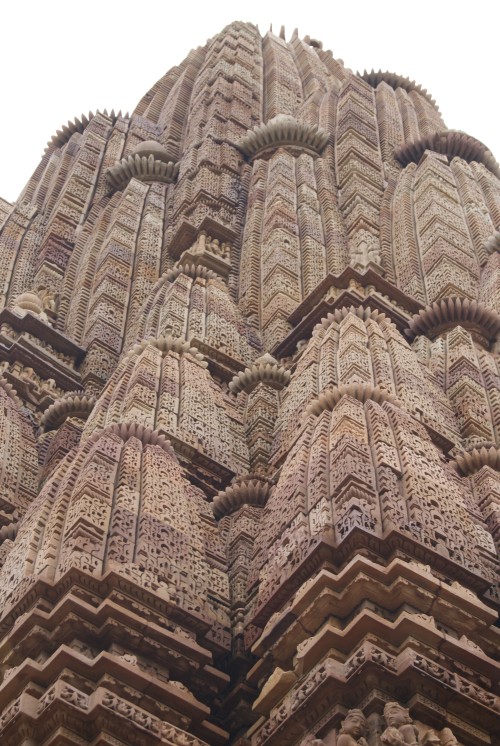




Pingback: Khajuraho – The Philosophy | Hobbies Of The Earth Bound Misfit
Amazing story of Khajuraho and superb sculptures & Art.